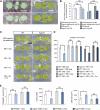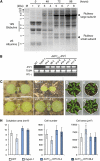Keep an eye on PPi: the vacuolar-type H+-pyrophosphatase regulates postgerminative development in Arabidopsis
- PMID: 21862707
- PMCID: PMC3180799
- DOI: 10.1105/tpc.111.085415
Keep an eye on PPi: the vacuolar-type H+-pyrophosphatase regulates postgerminative development in Arabidopsis
Abstract
Postgerminative growth of seed plants requires specialized metabolism, such as gluconeogenesis, to support heterotrophic growth of seedlings until the functional photosynthetic apparatus is established. Here, we show that the Arabidopsis thaliana fugu5 mutant, which we show to be defective in AVP1 (vacuolar H(+)-pyrophosphatase), failed to support heterotrophic growth after germination. We found that exogenous supplementation of Suc or the specific removal of the cytosolic pyrophosphate (PPi) by the heterologous expression of the cytosolic inorganic pyrophosphatase1 (IPP1) gene from budding yeast (Saccharomyces cerevisiae) rescued fugu5 phenotypes. Furthermore, compared with the wild-type and AVP1(Pro):IPP1 transgenic lines, hypocotyl elongation in the fugu5 mutant was severely compromised in the dark but recovered upon exogenous supply of Suc to the growth media. Measurements revealed that the peroxisomal β-oxidation activity, dry seed contents of storage lipids, and their mobilization were unaffected in fugu5. By contrast, fugu5 mutants contained ~2.5-fold higher PPi and ~50% less Suc than the wild type. Together, these results provide clear evidence that gluconeogenesis is inhibited due to the elevated levels of cytosolic PPi. This study demonstrates that the hydrolysis of cytosolic PPi, rather than vacuolar acidification, is the major function of AVP1/FUGU5 in planta. Plant cells optimize their metabolic function by eliminating PPi in the cytosol for efficient postembryonic heterotrophic growth.
Figures







Comment in
-
A surprising role for vacuolar pyrophosphatase.Plant Cell. 2011 Aug;23(8):2808. doi: 10.1105/tpc.111.230813. Epub 2011 Aug 23. Plant Cell. 2011. PMID: 21862706 Free PMC article. No abstract available.
Similar articles
-
Excess Pyrophosphate within Guard Cells Delays Stomatal Closure.Plant Cell Physiol. 2019 Apr 1;60(4):875-887. doi: 10.1093/pcp/pcz002. Plant Cell Physiol. 2019. PMID: 30649470
-
Vacuolar Proton Pyrophosphatase Is Required for High Magnesium Tolerance in Arabidopsis.Int J Mol Sci. 2018 Nov 16;19(11):3617. doi: 10.3390/ijms19113617. Int J Mol Sci. 2018. PMID: 30453498 Free PMC article.
-
Pyrophosphate inhibits gluconeogenesis by restricting UDP-glucose formation in vivo.Sci Rep. 2018 Oct 2;8(1):14696. doi: 10.1038/s41598-018-32894-1. Sci Rep. 2018. PMID: 30279540 Free PMC article.
-
AVP1: One Protein, Many Roles.Trends Plant Sci. 2017 Feb;22(2):154-162. doi: 10.1016/j.tplants.2016.11.012. Epub 2016 Dec 16. Trends Plant Sci. 2017. PMID: 27989652 Review.
-
Plant proton pumping pyrophosphatase: the potential for its pyrophosphate synthesis activity to modulate plant growth.Plant Biol (Stuttg). 2019 Nov;21(6):989-996. doi: 10.1111/plb.13007. Epub 2019 Jun 5. Plant Biol (Stuttg). 2019. PMID: 31081197 Review.
Cited by
-
Arabidopsis type I proton-pumping pyrophosphatase expresses strongly in phloem, where it is required for pyrophosphate metabolism and photosynthate partitioning.Plant Physiol. 2015 Apr;167(4):1541-53. doi: 10.1104/pp.114.254342. Epub 2015 Feb 13. Plant Physiol. 2015. PMID: 25681328 Free PMC article.
-
Oil and protein accumulation in developing seeds is influenced by the expression of a cytosolic pyrophosphatase in Arabidopsis.Plant Physiol. 2012 Jul;159(3):1221-34. doi: 10.1104/pp.112.198309. Epub 2012 May 7. Plant Physiol. 2012. PMID: 22566496 Free PMC article.
-
Class III compensation, represented by KRP2 overexpression, depends on V-ATPase activity in proliferative cells.Plant Signal Behav. 2013 Nov;8(11):e27204. doi: 10.4161/psb.27204. Epub 2013 Dec 4. Plant Signal Behav. 2013. PMID: 24305734 Free PMC article.
-
Precocious cell differentiation occurs in proliferating cells in leaf primordia in Arabidopsis angustifolia3 mutant.Front Plant Sci. 2024 Apr 16;15:1322223. doi: 10.3389/fpls.2024.1322223. eCollection 2024. Front Plant Sci. 2024. PMID: 38689848 Free PMC article.
-
An auxin signaling network translates low-sugar-state input into compensated cell enlargement in the fugu5 cotyledon.PLoS Genet. 2021 Aug 5;17(8):e1009674. doi: 10.1371/journal.pgen.1009674. eCollection 2021 Aug. PLoS Genet. 2021. PMID: 34351899 Free PMC article.
References
-
- Anastasiou E., Lenhard M. (2007). Growing up to one’s standard. Curr. Opin. Plant Biol. 10: 63–69 - PubMed
-
- Clough S.J., Bent A.F. (1998). Floral dip: A simplified method for Agrobacterium-mediated transformation of Arabidopsis thaliana. Plant J. 16: 735–743 - PubMed
-
- De Angeli A., Monachello D., Ephritikhine G., Frachisse J.M., Thomine S., Gambale F., Barbier-Brygoo H. (2006). The nitrate/proton antiporter AtCLCa mediates nitrate accumulation in plant vacuoles. Nature 442: 939–942 - PubMed
Publication types
MeSH terms
Substances
LinkOut - more resources
Full Text Sources
Molecular Biology Databases

